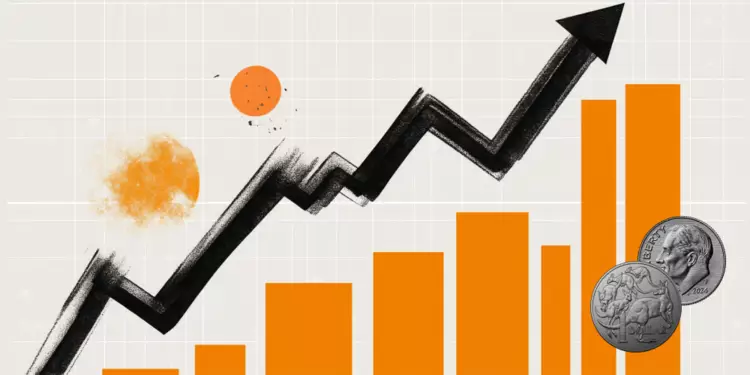The Australian Dollar (AUD) finds itself strong yet precariously positioned as global economic tensions escalate due to dramatic increases in U.S. tariffs on Chinese goods, which have surged to 145%. This mounting pressure highlights the fragility of international trade relations, particularly for Australia, whose economy is deeply intertwined with China’s market. The rise in tariffs is not merely a statistic; it represents an increasing chill in U.S.-China relations, a development that negates the stability Australia attempts to achieve through its export-heavy economy. While the AUD has seen gains against the U.S. Dollar (USD) in the short term, these numbers do little to assuage fears about a potentially deeper economic fallout stemming from the ongoing trade disputes.
Compounding these worries is the Australian government’s announcement of a potential restart to trade negotiations with the European Union (EU). Such discussions could pave the way for bolstering trade ties outside of the Asian sphere, offering a glimmer of hope in an uncertain landscape. However, optimism must be tempered—trade relations with the EU remain complicated and far from assured. Australia’s dependence on China for exports makes the notion of diversifying to the EU a precarious balancing act. The recent talks between China and the EU, aiming to enhance their own trading relationship, only underscore the challenges Australia faces in maintaining its maritime economic position.
Pressure on the U.S. Dollar
As the U.S. grapples with its own economic challenges, the USD remains under significant pressure. Recent U.S. economic indicators have shown a mixed bag; for instance, the Consumer Price Index (CPI) experiences a downward shift from 2.8% to 2.4% year-over-year. Although lower inflation may seem beneficial, it simultaneously lingers below expected levels, casting a pall on economic optimism. The USD’s struggles are compounded by ongoing discussions surrounding monetary policy from the Federal Open Market Committee (FOMC), which indicates a recognition of the dual challenge of handling inflation while promoting economic growth—an almost Sisyphean task for current policymakers.
Investors keenly await updates on the U.S. Producer Price Index (PPI) and preliminary Michigan Consumer Sentiment data. The outcomes of these reports will likely influence market sentiment and the movement of currency pairs globally. The inherent unpredictability of these economic indicators only reinforces caution among investors, who appear to be shifting into more secure assets in a risk-off environment.
AUD’s Technical Standing
Currently, the AUD/USD pair hovers around 0.6230, exhibiting signs of bullish momentum. The daily charts reveal the AUD trading above key technical indicators like the nine-day Exponential Moving Average (EMA); however, the Relative Strength Index (RSI) remains cautionary, sitting below the 50 mark. This is where market volatility often plays a decisive role—should the AUD breach immediate support at 0.6176, it could translate into a rapid retreat toward lower thresholds, such as the psychologically significant level of 0.5900.
The intricacies of technical trading must be explicitly acknowledged in today’s volatile market. A failure to maintain upward momentum could lead to a rapid depreciation of the AUD, completely transforming current bullish sentiments. Thus, traders should proceed with a keen eye on market trends and sentiment shifts, particularly in light of upcoming economic reports from both Australia and the U.S.
The ‘Risk-On’ vs. ‘Risk-Off’ Paradigm
In financial markets, understanding the difference between ‘risk-on’ and ‘risk-off’ environments is paramount. During periods characterized as ‘risk-on’, investors display a willingness to engage in higher-risk investments like commodities, which favors currencies from commodity-exporting nations such as Australia, Canada, and New Zealand. As the global economy appears unsettled, we see the scales tip back into a ‘risk-off’ state, where safe-haven currencies, notably the USD, Japanese Yen, and Swiss Franc, begin to show strength.
The current geopolitical uncertainties have led many investors to navigate cautiously, opting for safer harbor in the relatively unscathed U.S. treasury bonds and other secure assets. Here lies a paradox: while the AUD may continue recovering mildly against the USD for the short term, its long-term sustainability remains contingent upon greater global stability and improved trade relations.
Impacts on Australian Economic Outlook
As global events continue to unfold, the impact on Australia’s economic outlook remains a source of ongoing speculation. With expectations of significant cuts in interest rates being priced into the market—up to 100 basis points by year-end—the Reserve Bank of Australia’s (RBA) stance may shift to a dovish inclination, responding to deteriorating consumer and business sentiments. What remains most concerning is the possibility of a downturn in economic activity due to reduced consumer confidence stemming from external economic pressures.
With these intricate webs of global trade dynamics, economic indicators, and interest rate expectations, the broader narrative surrounding the Australian Dollar paints a complex picture. Investors and policymakers alike must navigate a multitude of factors, each with potential ramifications for Australia’s economic health. The interplay between domestic policies and international relationships will ultimately determine the AUD’s trajectory as it faces the volatile seas of global economic change.

